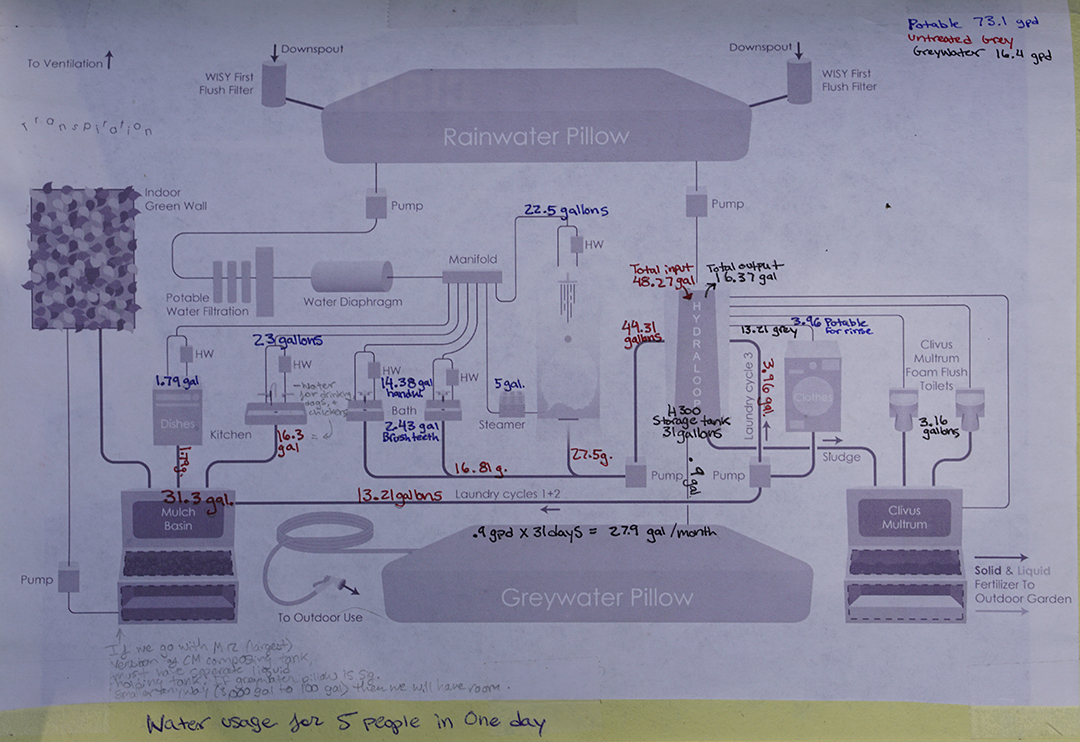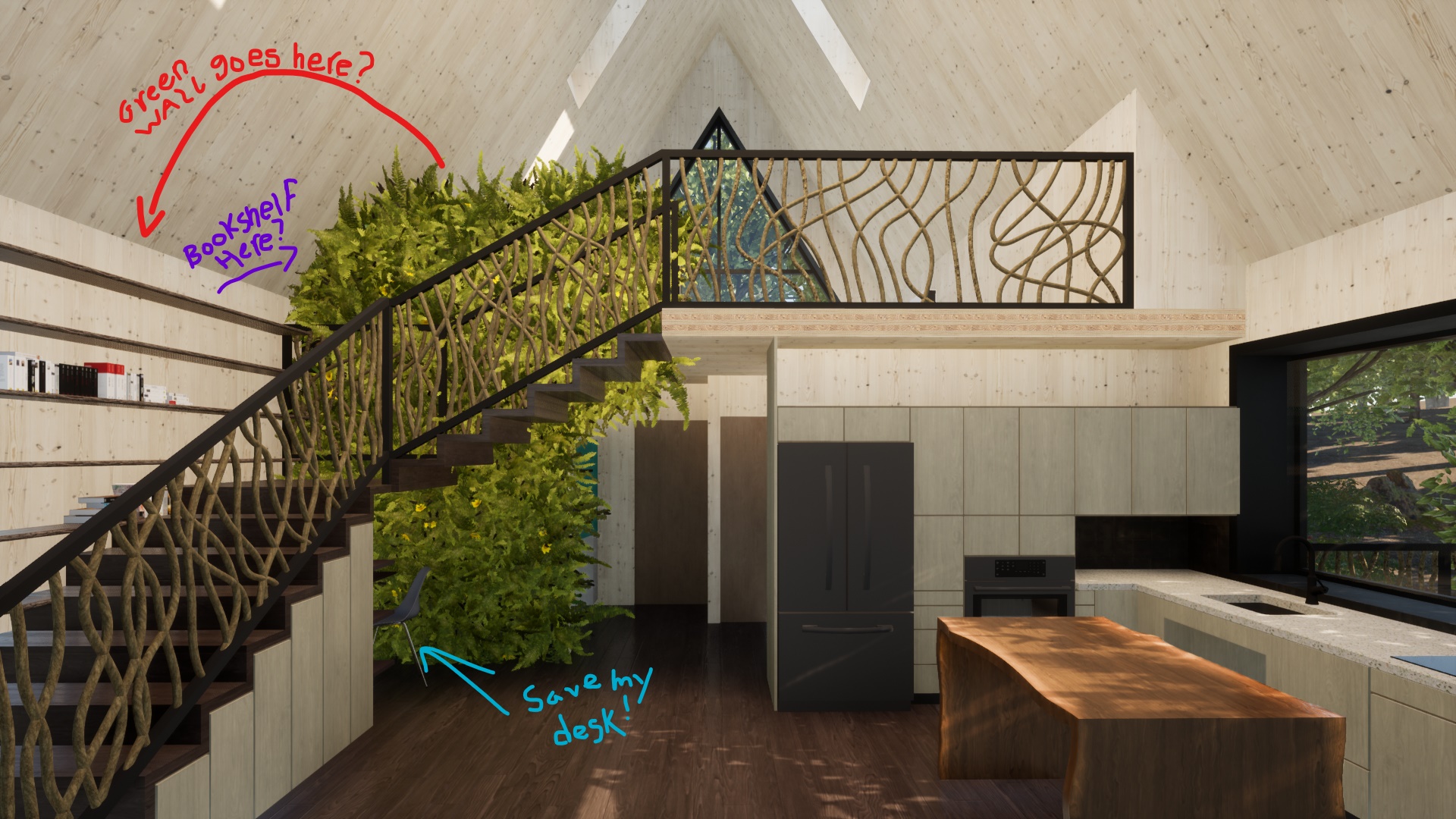The Too-Much-Mulch-Basin-Filtered-Greywater Conundrum
Dear Readers,
We have a slight conundrum. Nothin’ new…just thought I’d start working it out through writing, while simultaneously perhaps picking your brains for ideas 🙂
William and I have been working diligently to not only find ways to cut our overall water consumption so that we can comfortably rely solely on rainwater collection for all our potable and non-potable needs, but we have also been attempting to treat all of our wastewater on-site while still meeting PA DEP codes. If you have read “The Water Cycle of the Seed III?” then you are familiar with our aim to keep all of the treatment of the water within our home’s envelope in order to achieve our end goals and comply with said code.
Well, the PA DEP took the time to look at our home’s nifty water cycle diagram, and they were pretty unofficially ok with it! We will have to pursue an experimental permit, and verify a couple of things with our local code officials…but…overall, it was at least a ‘green light’ to continue chuggin’ along with our current plan and see what becomes of it. Which is super exciting!!
However, that does lead to this latest conundrum: Given the ‘go ahead,’ we took a closer look at our mulch basin. We quickly realized that our mulch basin is going to receive a disproportionately large amount of greywater in need of treatment each day, in comparison to the amount of water that our prospective indoor green wall is actually going to need.
Anticipated water flows in one day for five people!
Explaining the madness above: Based upon our previously calculated water usage and habits, in combination with our newly integrated water-saving and reusing technologies, and with the assumption that there will be us and our ‘maybe three children’ living in this house, we mapped out the water flows for a day in the life of five people chilling in The Seed.
What we found: Provided that we do indeed do a load of laundry and run the dishwasher once every day (which, with maybe five people in one house, that very well is possible), our mulch basin will have to be able to filter and store about 30 gallons of greywater per day. That’s a lot.
Which is kinda sorta crazy when you think about the fact that only .9 gallons per day are going into our greywater pillow for outdoor non potable usages…that’s 27.9 gallons per month…which is still less than what our mulch basin will be getting in a day. Sooo…that leaves us with very little water for irrigating outdoor gardens, and way too much water for irrigating our indoor green wall. Ha!
Why is an anticipated amount of 30 gallons of water per day too much for a maybe 108 square foot indoor green wall?
Welp! One of the green wall manufacturers we were communicating with, expressed that a 108 square foot green wall (which is about the size ours will be) will only need to be watered every 7 to 10 days, with a water demand of 20 gallons per cycle.
In our case, assuming the worst, and our plants only need to be watered every 10 days…in ten days our mulch basin will have filtered and sent to a separate storage tank an accumulation of about 300 gallons of treated greywater. When the irrigation lines click on to water our indoor green wall, 20 gallons will be used. That still leaves 280 gallons of treated greywater being stored beneath our home, waiting to water something…and while those gallons are anxiously waiting to be used, they are accumulating. Every. Single. Day. By, like, 30 gallons.
Conundrums.
I could write out the math for what a month would potentially look like, but that just sounds depressing.
So, here we sit. There is no point in just having a super large storage tank for the treated greywater, because the ratio of usage to accumulation would be just ridiculous…the storage space would fill up and be null and void and our plants will still be like “nah, I’m not thirsty…”
So. Plant harder? I did have the thought that we could cover our home’s walls…every available interior foot…with a green wall. I do love green. But that seemed like too much…and exterior walls are out of the question. An exterior green wall that used our filtered greywater for irrigation would make the whole “staying in the home’s envelope thing” irrelevant and we risk pushing the boundaries of code more than we already are. Plus, plants outside go dormant in the winter. And it is not like we are going to stop doing our laundry and washing dishes in the colder months just because our outdoor garden needs to take a nap and doesn’t need water.
Ha! Soo..plant smarter? Not harder? I had the thought today when I was on a run that we should just switch our walls. William likes the idea. It means he would have to, yet again, redo his beautiful renderings…but he likes the idea…and enjoys doing renderings.
Moving green wall to maximize plant health and therefore water demand? Maybe?
Right now, our green wall is directly opposite our westward-facing windows, and is perpendicular to our southern-facing windows and skylights. The green wall is also currently invading the little reading nook below the stairs. This in itself poses two problems: One, below the stairs will not get a lot of light and those plants would need some form of artificial light to keep them alive (and, unhealthy plants don’t need as much water…because they are sickly and dying and weak). Two! I really want to put my antique desk in the reading nook. It is beautiful and has little dragon claw feet. And I don’t want it to become a moldy mess. While we will of course have our ventilation system working hard all year round for our green wall and our home’s overall interior air quality, wooden things in dark corners near damp plants and soil usually means mold.
So! If we were to put the bookshelf where the green wall currently is, and then the green wall where the bookshelf currently is….that would be cool and maybe be at least slightly helpful.
The bookshelf is directly opposite the southern-facing windows and skylights, and it is much more open (with not having the little dark cozy reading nook and all…). This could lend itself to having healthier plants which more vigorously enjoy water, as well as maybe even a slightly larger wall space. The current green wall is about 108 square feet in size. Not sure how big the wall is where the bookshelf currently is…William is working on his real job right now and is too busy for my wall-swapping.
Annnddd…there you have it. That is the extent of my ideas thus far to make head-way in our too-much-mulch-basin-filtered-greywater conundrum. If you have any ideas, please feel free to comment or contact me at shelby@sustainingtree.com.
Thanks a mulch!
Shelby
4 Comments
Submit a Comment
© 2020 Sustaining Tree
© 2020 Sustaining Tree



Oh my! Can’t some of it be put into drainage pipes in surrounding areas?
Hey Aunt Rose!! That is an idea! We will have to run it by code. The mulch basin is technically not NSF certified, and to send the mulch-basin treated greywater out of the home’s envelope to an outdoor absorption field, if approved, would have to be included in the experimental permit. Which! If we are getting an experimental permit anyways…it is worth a shot!
I guess the only other downside to sending the treated greywater to an outdoor absorption field would be a complication in prefabrication purposes. If we can keep our entire water treatment system within the home’s envelope, it would be easier for others to buy the home and have it plopped on a piece of land and be sooner ready to inhabit.
All food for thought…you certainly got the wheels a turnin’ in William and I’s heads! Thank you!!!!! <3 🙂
Toilets are the biggest water user, so switch to incinerator toilets. Showers are second.
Do you have or could you add a system dedicated to the showers -https://goexplorer.org/instant-water-recycling-creates-closed-loop-shower-system/ .
What you are already doing should work for laundry, washing dishes and such by adding something like a https://www.hydraloop.com/ to reuse gray water for everything else except the shower – After a set number of cycles it could empty into your existing system to water the green wall? Water use would go way down so you wouldn’t have an issue with constant accumulation. I’m building a bus and using these systems so I can make my fresh water supply last much longer.
Hey Marcia! I apologize for such a delayed response~ we really are thankful that you read our blog and left some awesome recommendations!!
First off…hot dang! The Global Opportunity Explorer is quoting the Orbital Shower system of using only 5 liters of water per 10 minute shower?! That is absolutely incredible. When we first were looking into the Orbital Shower, they were claiming of using 30 liters of water per 10 minute shower! I will have to reach out to Orbital~ because if their numbers are indeed at 5 liters of water/10 minutes, then that is an incredibly viable option. In that case, we might as well ditch the steamer idea! 🙂
For the Hydraloop, they unfortunately do not accept kitchen water for treatment 🙁 They consider kitchen water as “black water” because it is so nutrient rich. And, they are not the only ones. William and I have been struggle busting to find a system willing to touch kitchen water, hence the mulch basin idea. If you come across any systems/manufacturers who treat kitchen water to NSF standards, please, please let us know!! We are in quite the pickle on that one.
And using water-reuse systems on a bus to conserve your water supplies is awesome! Will you be taking the bus cross-country? My cousin and her husband went on such an adventure, and I’m sure some of these water-saving ideas would’ve been interesting to them!
Thanks again for reading!! And we send well-wishes to you on your bus project!! 🙂